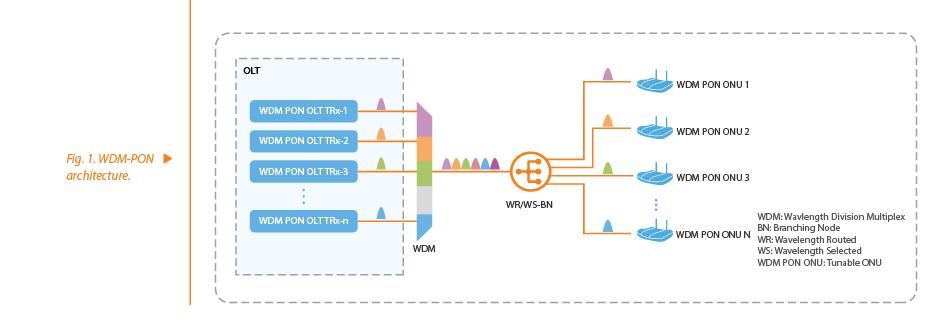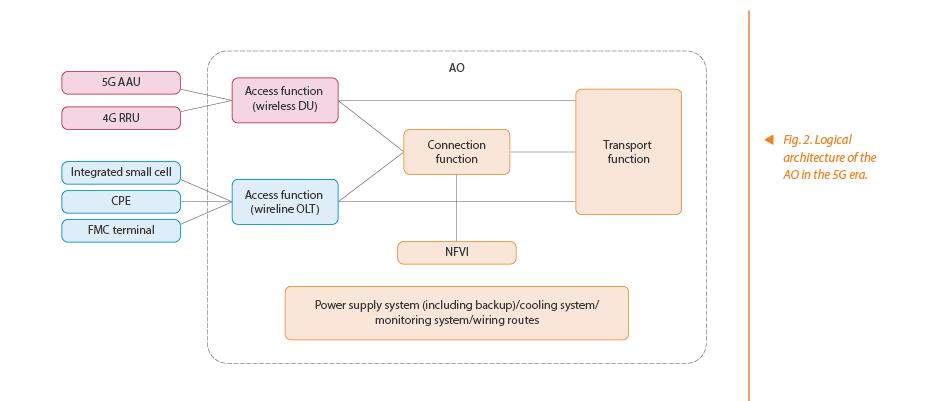Evolution of Optical Access Network in 5G Era

Challenges and Opportunities
As the information and communication infrastructure most crucial to the digital transformation of society, 5G will enable an internet of everything (IoE) that links humans, machines, and the environment more closely and efficiently. The resulting communication connections are convenient, superfast, intelligent, and reliable. The ubiquitous connectivity will lead to innovation and evolution in production modes, business models, and people's lifestyles.
Compared with 4G, 5G can provide stronger communication services that are classified into three scenarios. The enhanced mobile broadband (eMBB) scenario delivers peak rates of 10 Gbps. The massive machine-type communication (mMTC) scenario enables up to one million connections per square kilometer. The ultra-reliable low latency communication (uRLLC) scenario offers 1 ms end-to-end latency and can generate new applications such as the internet of vehicles (IoV).
With its increased bandwidth, reduced latency and stronger IoT support, 5G poses huge challenges for the legacy optical access network. First, for mobile broadband users, 5G boosts the bandwidth to 1–10 Gbps and shrinks the latency to 1–10 ms, which almost equals the performance traditionally delivered by fixed optical access. Therefore, traditional optical access loses its advantages over 5G in bandwidth and latency. Second, while the IoT carried by an optical access network requires gateways to operate, the 5G IoT features wide coverage, easy service provisioning and standardized interfaces while boasting simpler operation and maintenance (O&M) and lower cost.
The development of 5G also brings new opportunities to optical access network. First, 5G uses an architecture where AAU and DU are separate. In addition, because 5G operates at high-frequency bands, it requires more than twice the number of antennas (AAUs) compared to 4G. This makes the fronthaul network a crucial part of the 5G puzzle, with fiber resources being the key to 5G deployment. The existing high-density ODN can be easily connected to 5G AAUs at low cost, creating bright application prospects for WDM-PON. Second, 5G employs high-frequency signals that has weak penetration through walls. There is also the problem of declining bandwidth and unstable access quality at the edge of a 5G wireless network. By contrast, the optical access network holds an enormous advantage in this respect because it can offer bandwidth and quality of service (QoS) that are unrelated to how far the user is from the central office.
Operators can combine the advantages of 5G access and optical access to make them complement each other. By utilizing substantial fiber resources of the existing ODN as well as stable high bandwidth access, operators can provide users with stable, reliable 5G+FTTH dual gigabit access.
Evolution Trends and Hot Technologies
To enable 5G+FTTH dual gigabit access, an optical access network needs to accommodate how wireline-wireless convergence evolves specifically in terms of planning and construction, network architecture, and technology roadmap.
When planning optical network coverage and constructing an access office (AO), operators need to consider both current service coverage and future expansion. An effective method is to establish independent integrated access areas according to the access requirements of services including fixed home broadband, base station transport, and enterprise private line, as well as in the light of administrative and natural divisions, road network architecture, and customer distribution. Each integrated service access area has a dense-coverage ODN and a converged AO where OLTs, BBUs/DUs and wireline transmission devices are deployed in a unified manner for fixed-mobile convergent access.
From the network architecture perspective, the converged AO serves as the point of presence (POP) for user access and is an important node where services are identified and steered to the cloud. A large-capacity converged AO reduces the number of AOs and allows the operator to simplify the network. The converged AO unifies service models, AO specifications, technology choices and networking plans, facilitates the evolution to SDN, and introduces AI to achieve smart O&M. This helps operators significantly simplify the construction, operation and maintenance of their optical access networks and reduce Opex.
Technically, 10G PON wireline access and 5G wireless access are introduced to deliver a bandwidth of over 1 Gbps for each user to enjoy ultimate experience of new services like 4K, 8K, VR and AR. By deploying network functions virtualization infrastructure (NFVI) to the AO and adopting multi-service edge computing (MEC) technology, low latency can be produced to enable new real-time services including VR, IoV and remote control.
To make more efficient use of ODN resources, several PON technologies based on point-to-multipoint (P2MP) architecture have emerged, including WDM-PON for 5G fronthaul and 50G PON for higher bandwidth.

WDM-PON is a P2MP architecture that uses independent wavelengths to provide each user with a rigid pipe (Fig. 1) With a maximum rate of 25 Gbps, WDM-PON meets the requirements of 5G fronthaul. Operators can deploy WDM-PON by largely reusing the existing ODN to save trunk fiber resources. Because WDM-PON is suitable to deliver 5G coverage for dense urban areas, it is a major technological option for 5G fronthaul. At present, WDM-PON still has the problems of high cost and low reliability under outdoor conditions that need to be solved by advancing the industry chain.
Standardization of 50G PON as the next-generation PON technology was initiated by the ITU-T in 2018. 50G PON employs the single wavelength technology and is compatible with XG(S) PON or GPON. Thanks to the low-latency dynamic bandwidth allocation (DBA) technology, 50G PON can substantially decrease the upstream latency. This allows 50G PON to not only boost bandwidth for home broadband but also suit new applications including enterprise private line and 5G base station backhaul. With its ability to vastly expand the application scope of PON technology, 50G PON represents the optimal technological evolution path for operators wishing to fully use their existing ODNs.
Thoughts on Optical Access Network Construction
The key to optical access network construction in the 5G era is to develop the converged AO into an intelligent fixed-mobile convergent AO that is easy to maintain, flexible, and reliable. While the existing power supply system (including power backup equipment), cooling system, monitoring system and wiring routes of the AO are kept intact, its internal network is divided into four functions (Fig. 2).
—Connection function: Using a leaf-spine data center topology, the AO can build a high-bandwidth, scalable and reliable internal communication network to support complex communications among the DU (wireless), OLT (wireline), uplink transmission equipment, and NFVI with QoS assurance.
—Access function: The DU is used for wireless access processing, while the OLT for wireline access processing.
—NFVI (computing and storage function): The NVFI can serve as a remote module of the edge data center (EDC) and the NFV services running on it are centrally orchestrated and managed by the 5G core network. The NFVI is intended to ensure that low-latency, real-time services can be rapidly processed to improve user experience.
—Transport function: The AO provides network-side interfaces to centrally carry wireline and wireless traffic from the OTN, IPRAN or SPN equipment.
Since AOs exist in large numbers and vary greatly in their hardware conditions and environments, transforming all of them in one stroke will incur a huge investment and an enormous workload. Instead, they should be evolved step by step based on the following principles:
—Openness: The interfaces among access function, connection function, NFVI (computing and storage function) and transport function should be open. The NFVI is shared by all the functions and users of the AO.
—Scalability: AOs vary significantly in their hardware conditions including the floor area, power supply system and cooling equipment. The access function, connection function, NFVI (computing and storage function), and transport function in the AO can be trimmed according to service needs and smoothly expanded as per functionality and capacity.
—Flexibility: The reconstruction of the AO should be based on smooth evolution of the AO's existing architecture. Functions can be flexibly deployed according to the conditions of the AO without affecting the operation of existing services.
The optical access network is still of great value in the 5G era. By utilizing ubiquitous ODN resources, operators can match the size of their converged AOs with the number of users and share converged AOs and MEC resources. The converged AOs can be intelligently transformed by evolving PON technologies and introducing SDN and NFV. These measures combined will simplify service deployment and O&M.
ZTE has launched a converged AO re-architecture solution based on a deep understanding of optical access networks and broadband access services. It is also a frontrunner in the PON space by virtue of its continuous innovation in WDM-PON and 50G PON technologies. ZTE will adhere to the idea of building ultra-fast, ultra-simple, and ultra-premium networks while maintaining in-depth cooperation with operators to advance the rollout of 5G+FTTH dual gigabit access services.